The Indian Pacific Railroad – Perth to Sydney
Posted on January 5th, 2005
Boarding the Indian Pacific (IP) was a big moment for me. I had first learned
about the journey from good ol’ Bill Bryson’s “Down Under”
and after further research, I decided that this was something I had to experience
for myself. I should say here that under normal circumstances, I am not the
type of person that gets overly excited about sitting still in cramped quarters
for long periods of time unless booze, video games and/or (preferably and)
open-minded, naked nymphs are involved. But the idea of crossing this huge,
baked continent overland in three days, taking in the outstanding scenery, all
the while in air conditioned, well appointed surroundings, being lavishly fed
and doted on constantly had a strange and unexpected attraction for me. Then
I looked at the price list. Jesus. I could fly round-trip from Sydney to London
for less than a one-way IP journey in first class.
Going against my usual masochistic transportation electives, I had already
resolved that first class, in a private cabin with a soft bed would be a requisite
for the IP journey. Having braved many long train journeys in Europe, I knew
that 65 hours in an upright train seat would rank up there on the Comfort Scale
with emergency hemorrhoid surgery, except with less dignity. More importantly,
after that nightmarish three day bus ride from Cadiz, Spain to Iasi, Romania
in June, I decided that I had filled my lifetime quota of multiple-day constant
travel that didn’t include a bed, a shower and alcohol.
But clearly, paying for the trip myself was out of the question. This sparked
my very first round of unsolicited story pitches to magazines in the hopes that
I could get an editor hyped enough about the journey to kick out an assignment
letter which would, in theory, land me a comped trip. This burst of enthusiasm
ran out of steam after sending pitches to only two magazines. The sad fact was
that I had way too much on my plate at the time (two outstanding, paying article
assignments, my journal, web site upkeep and, oh yeah, travel) and I simply
did not have the necessary time to sit on the Internet for a couple days researching
appropriate magazines and sending out tailor-made pitches. Both magazines turned
me down. I gave up and refocused on the tasks at hand.
Two weeks later, Travel Savvy, a year-old, bi-monthly, upscale travel magazine
out of New York with a 120,000 readership changed their mind and suddenly wanted
me to arrange the trip immediately. I had been submitting finished articles
to Travel Savvy for months and they had turned me down every time, but always
with compliments. This mild encouragement kept me coming back for more and now
one of my offers and their needs had finally synchronized.
So I got to work. I spent five days conducting screaming business conversations
over Aussie pay phones – I believe there is a zoning law that requires
all Australian public pay phones to be located on busy streets, frequented by
heavy trucks, motorhead cars and motorcycles with the carburetor intentionally
mis-adjusted - and emailing people, begging for free stuff. Tim, my Travel Savvy
editor, was a dream and held my hand through the process of my very first self-arranged
trip. His letters of assignment not only got me booked on the IP train zip-zop,
but he also came through by drafting a second assignment letter that won me
a comped flight from Sydney to Perth with Virgin Blue, saving me a huge out-of-pocket
expense.
During the weeks leading up to the trip my mind started to play tricks on me,
like maybe the whole arrangement was a personal fantasy that had gotten out
of hand or perhaps it had all been an elaborate hazing ritual perpetrated by
the travel writing community (those guys are so wacky). I mean honestly, people
were going to give me stuff? A free plane ticket? First class train
passage, in a twin cabin with a private bathroom and all meals included on the
world’s only remaining trans continental railroad? This wasn’t really
happening was it?
I waited for the other shoe to drop all the way up until check-in. The ladies
at the Indian Pacific desk had a bit of trouble finding my reservation. Since
the trip had been booked by Rail Australia’s marketing department and
not a travel agent, there was some confusion which instigated a small conference
behind the desk. “This is it,” I thought. “Here’s where
someone jumps out and yells ‘Ha ha! Got ya, suckaaaaaaah!’”
Well, they sorted it out and a few minutes later I was occupying a twin cabin
in carriage ‘I.’ The onboard IP staff were just as I had expected,
dedicated and professional while exuding the relentlessly disarming Aussie brand
of joviality. Before they opened the train for boarding, the staff lined up
out on the train platform, the train manager introduced himself, welcomed us,
blew a whistle, the staff yelled “All aboard!’ in unison and we
were on our way.
My wood-paneled, twin cabin was small, as expected, and fully outfitted. The
living area was about six long and four feet wide. In the day configuration,
the cabin had a three seater lounge, a fold down table, a small face mirror
with light, a narrow, full-length mirror on the back of the cabin door, two
small garment closets, an overhead storage shelf that was too small and too
inaccessible for my main backpack, and a modest picture window for admiring
the scenery. The night configuration was essentially the same, with the back
of the lounge folded down, revealing a small, but comfortable single bed. Being
in a twin cabin, I also had a private bathroom. About the size of an airplane
bathroom, without the lost space from the fuselage curve, the little closet
had a fold-away sink, a fold-away toilet, a shower, an overflowing towel compartment,
a toiletries shelf, a small mirror and a very weak light that was nearly entirely
blocked out when the shower curtain was closed. The cabin also had a rudimentary
sound system that gave one the choice of listening to the train’s onboard
radio station (this channel was also occasionally used to play commentary that
went along with the scenery passing outside) and channels labeled “Music
1,” Music 2,” and “TV Sound” that were all eternally
dead. Wait, TV sound? Who had a TV and what time were the Simpsons on?
Displayed on the lounge, was a pile of brochures with information on the IP,
along with a journey guidebook and a Great Southern Railway (GSR) Magazine which
amounted to a thinly veiled advert for the other GSR train services. There was
also a welcome kit that included a small bar of soap – I eventually I
found two additional bars of soap hidden throughout the cabin - shampoo, conditioner,
moisturizer, a sewing kit, an alcohol soaked sponge (I assume for make-up removal),
re-hydration spray (for re-hydrating what, I’m not sure), a dental kit
and a soft, cloth bag whose purpose I couldn’t guess, but it was so soft
and fuzzy that I decided to use it to clean my glasses. Finally, there was a
very official looking, cardboard package on the mirror shelf that contained
two Indian Pacific lapel pins and a collection of brochures detailing the route
timetables, the off-train tours, a journey map and a summary of onboard services.
I had just finished nearly two uninterrupted months of backpacker living with
occasional bouts of trying to be a well-behaved guest in stranger’s homes.
I was ready for some unrestricted privacy, unashamed sloppiness, comfort and
at-home-like laze. Since I was already stinky from running around in the melt-your-hair
heat of Perth all morning, I chose to start off in true, extravagant, Homer
Simpson style, by immediately jumping into the shower for a long, hot, wash-down,
using copious soap, shampoo and even the conditioner, despite the fact that
my hair was barely ¼ inch long and I fully intended to shave myself to
the skin upon arrival in New Zealand in four days time. All of this went down
before the train even left the station. Then I slathered myself in the moisturizer,
put on clean clothes, doused myself in cologne and set out to explore the train.
There were two cabin cars between mine and the common area carriages. The corridors
were very, very narrow, making it impossible for two adults to pass without
men getting visibly apprehensive and women getting their breasts grazed. After
two chest-to-chest nipple brushes, I switched to doing butt-end passes so any
incidental breast contact would be made less intimately on my back and there
would be no hope of the dreaded male-on-male, johnson contact.
I immediately located the compartment at the end of my car where the drinking
water and complimentary tea and coffee were stored. (I later found out that
this little box was also where my carriage porter slept at night.) after side-stepping
through two cars, I arrived at the lounge car, which still had a light tang
of cigarette stench even though the onboard smokers had been consigned to a
tiny, air-tight, glassed, fish-bowl-like booth years earlier when the train
went smoke-free. The lounge had 25 or so stuffed armchairs, a few side-tables
and piles of recent magazines and the day’s newspapers. There was a well-stocked
bar on one end, where I noted that the drink prices, which I assumed would be
astronomical, were virtually the same prices as in any restaurant.
The dining car was next, lined on both sides with small, but elegant tables
that seated four people, with soft, bucket seats and glass partitions between
each table.
No sooner had I skootched back to my cabin, I was summoned back to the dining
car for lunch via the train’s public address system. Being alone, I was
seated with another lone traveler named Jim, from Melbourne. Jim, a retired
stock market monkey and native of Glasgow, Scotland, had just had eye surgery,
necessitating a pirate patch over the ailing eye, that prevented him from flying
with the rest of his family from Melbourne to Perth for Christmas, so he was
on the train with me. My first direct encounter with the train staff was with
Linley, one of several people on the train that served the multi-purpose roles
of food server, cleaner, porter and morale booster. Without a single prior word,
Linley leaned in to Jim and said “Careful what you say to this guy mate,
he might put it in his article.”
Bugger. Less than an hour out of Perth and my cover was blown! Clearly Rail
Australia had alerted the staff that I was reviewing the IP, but how Linley
knew I was the writer I’ll never know - probably because I was easily
the youngest adult in first class - but the word was out. All the train staff
I met from that point on, without introductions, knew exactly who I was and
treated me like royalty. At first this annoyed and creeped me out, but I changed
my tune later on when the train manager appeared at my cabin door to chat me
up and inform that I would be comped on all of the off-train tours of the outback
towns we would visit and that, gulp!, I had unlimited access to the bar! Woo
hoo! Stand back people! It’s time to abuse my position! Lady, please stay
behind the red tape!
So, it was on. I had a team of alert Aussies coiled up, ready to do my bidding,
a river of wine and spirits and all the outback tours I could endure! Who knew
that begging for free stuff could be so fruitful?
After lunch we had a formal train orientation in the lounge car with complimentary
Champaign. I lingered after the presentation to read the newspaper’s thick
section on the Asian tsunami disaster. My hostel mates and I had been glued
to the evening news for the previous two nights watching the coverage like it
was 9/11. Many of us had either just come from Asia or were preparing to go
in the near future. My arrival in Asia was still over a month away, but I already
knew that my tour was going to be drastically abbreviated in Thailand and if
there was even a glimmer of hope for going to Indonesia, it was definitely squashed
now. The sheer number of casualties and the graphic descriptions of towns being
leveled, vacationing families being wiped out, babies being ripped from their
mother’s arms and carried out to sea and the imminent threat of a devastating
wave of diseases choked me up enough to put down the paper and return to my
cabin.
Dinner was agonizing in that I wanted a serving of all three main courses;
salmon, duck and filet mignon. I got the beef and a pricey glass of merlot with
a slice of chocolate mousse cake and coffee for dessert. Jim and I were joined
at dinner by an older couple from Perth, Peter and Pearle. Peter and Pearle
were heading to Tasmania in style for their first vacation together, without
the kids, in decades. I ended up eating every meal with this trio until all
three departed at Adelaide.
At 10:00PM that night, the train pulled into Kalgoorlie. In 1893 while a group
of Irish prospectors were heading to a reported gold strike site, one of their
horses threw a shoe and when the rider hopped off to retrieve it, he stumbled
on an exposed patch of gold. With a perfectly straight face, the rider quickly
covered the gold and casually went about his business. Later that night, he
let his two buddies in on the find. The three men agreed to work together and
share the find. The next morning, using the ruse that the shoeless horse needed
professional attention, the trio stayed behind as the group headed out. While
two of them guarded the find, the third, young Paddy Hannan set off to register
the strike. As was wont to happen in those optimistic times, word got out and
within days there was prospector chaos in the area. One hundred years later,
the “Superpit” is the world’s largest, single cut, open mining
operation, measuring in at nearly two miles long and 984 feet deep. These dimensions
are expected to double in size by the time work in the pit is complete in 20
years. Kalgoorlie is Australia’s biggest gold producer.
I had been supplied with a bus tour ticket - filled out by an as yet unacquainted,
but alert staff member who never asked my name and accomplished the astonishing
goal of spelling my name correctly on the first try - that would take several
of us to a special night time lookout to ogle the alleged dramatically floodlit
Superpit during the busiest part of its productive day. Word was that full-on
productivity was saved for night time when the punishing sun was out of sight.
Once that was over, we were to be taken through town to try to see and appreciate
some of the gold boom financed architecture through the dim night and finally
a pleasant drive down Hay Street where viewing the “Ladies of the Night”
(LOTN) was actually a highlighted item on the tour card. Only in Australia.
(And maybe Amsterdam.)
I had only gotten five hours of fitful sleep the night before, so my energy
levels were bottoming out before I even got on the bus. The ill-lit, strangely
quiet streets of Kalgoorlie did not help my alertness. I knew some people had
chosen to bypass the $18 bus tour in favor of wandering Kalgoorlie on their
own – something I would have undoubtedly done myself if I have not gotten
the freebie – but seeing the state of the near-empty, yet oddly menacing,
after-dark state of the city made me happy that I was seeing it from the safe
confines of the bus. Our driver/tour guide did a commendable job of trying to
make things interesting and fun despite the bleak Wednesday night city scene
– which was primarily composed of drunks and aimless, wandering Aborigines
- and the unfavorable lighting. We drove down several streets admiring historic
buildings before heading out to the pit.
The Superpit was super hard to see for our visit. There were precious few trucks
and digging machines working and thus very few of the promised solar system
of floodlights were shining. Apparently much of the pit crew were still on holiday
break, so the foreman was conserving electricity where appropriate (read; everywhere).
Despite this, we gave the Superpit our best shot, standing and squinting out
into the darkness for hints of pit-like features After allowing a few minutes
for our eyes to adjust, we could just make out the form of the pit and the chiseled
levels in the pit walls like giant steps and a tiny plume of dust drifting up
from an unseen work site on the far end of the pit. The novelty of this pathetic
searching wore off quickly and we were reduced to milling around and reading
the informational plaques posted around the lookout platform, detailing the
history of the gold strike and the pit.
Once back on the bus, we took a few more turns down notable city streets before
the much anticipated cruise down Hay Street. The LOTN were working out of tin
shacks, each with numerous doors where the LOTN sat, displaying themselves for
customers, like in Amsterdam’s Red Light District windows. One of the
shacks was even painted red in apparent homage.
The ladies in one shack weren’t too keen on our bus creeping up and then
stopping in front of their establishment. Two of them came out, waving wildly
for us to move on. We returned to the train after this climax. The tour was
actually half-decent all things considered, but the very ambitious $18 charge
for this service was indeed far more than I would have been willing to pay if
I hadn’t been comped.
Once on the train we were instructed to set our clocks an hour forward in anticipation
of the time zone crossing early the next morning. I climbed into bed and was
rocked to asleep instantly.
Six hours later my porter Debbie banged on my door to deliver my wake-up coffee.
I reached over from my bed and let Debbie in without even sitting up. She quickly
left the coffee on the floor inside the door and took her leave. I suppose she
was used to the old folks all being up, showered, shaved, primed and ready to
start the day rather than a groggy, mostly naked guy with a kickin’ body
mumbling incoherent directions from a prone position. I took a few sips of coffee
before easing myself into my tiny bathroom for yet another Homer Moment with
the shower, again making lavish use of every single item that was included in
the welcome toiletries kit, except for the toothbrush. I chucked the toothbrush
the night before due to the damage it was inflicting on my gums. The bristles
were stiff enough to not only clean grout, but probably remove it as well.
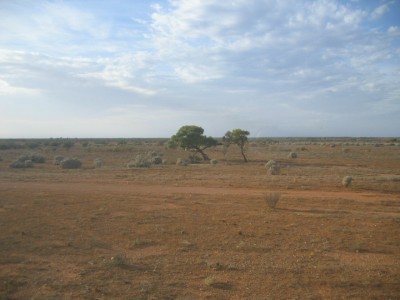 |
What little detail there had been to the surrounding landscape had petered
out over night. Looking out the window now, all that was visible was a flat
nothingness, all the way to the horizon, interrupted by the occasional defiant
tree or rock pile. On this day we would cover the longest stretch of straight
rail line in the world, 296 miles without a single curve, and stop in the town
of Cook, population two, to take on water and give us all a chance to stretch
our legs and see a modern, abandoned ghost town.
Breakfast was fantastic as expected. I ordered the scrambled eggs with a spiced
potato cake, bacon and toast, along with orange juice and two more coffees.
I also scored two sausages from Pearle’s plate. Fattened and woozy, from
the unusually large breakfast, I returned to my cabin to work on the Salzburg
article for about an hour before the effects of the coffee faded and I was forced
to take a short nap.
At noon we arrived in Cook, population two. I noted right away that Cook, population
two, had at least four people in it, though a joke circulating on the train
was that the extra people were vacationers on a prize vacation courtesy of the
Great Southern Railway. First prize was a week in Cook. Second prize was two
weeks in Cook. Bwa ha ha ha!
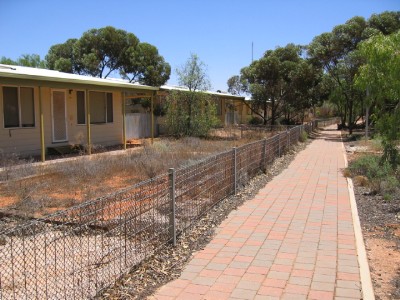 |
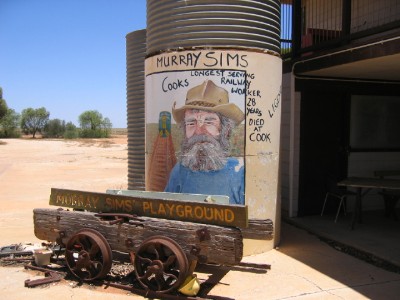 |
Cook would have been more aptly named “Baked.” As we exited the
pleasant air conditioned train environment, we were clobbered with what seemed
like 110 degree heat. It was a dry heat of course, which meant that none of
us actually broke a sweat because our perspiration was evaporating before it
could get a chance to bead up. Some people turned around and got right back
on the train, but most of us foraged on to see Cook, population four. Before
the Australian railways were privatized, Cook had a permanent population of
about 300 people who all worked to support the passing trains. In the mid-90s
this all changed and Cook was quickly abandoned. All of the houses and buildings
have been neglected, but they are still standing and in decent condition which
makes it seem very eerie. There is a two story school house, a pool that has
been filled in with dirt and even a nine hole golf course, without a single
blade of grass. Cook’s two (four) residents were clearly either teetering
on isolation induced weirdness or just plain lazy, because the entire town was
littered with trash, old train parts, abandoned vehicles, gutted kitchen appliances
and the like. No effort had been made to even place all of this wreckage in
a discreet place. Stuff was just laying where it had seemingly landed; in the
middle of the “street,” back yards, and even far out into the outback
behind the town.
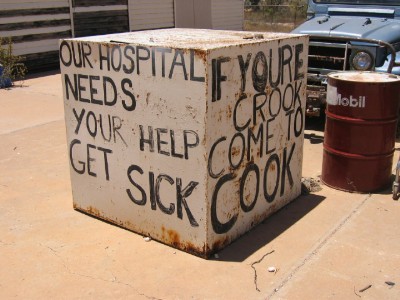
They were getting pretty punchy there at the end of Cook's mass abandonment. |
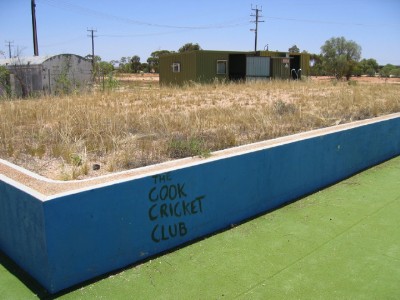
Once the Cook Pool, now the Cook Cricket Club |
We wandered around, sucking in the heat, taking pictures of some of the good
humored graffiti left behind by departing residents and visiting the Cook souvenir
shop where two massive ladies sat behind the register, ignoring us. Incidentally,
these two blobs now brought the Cook body-count up to six, assuming they had
not won fifth prize in the Great Southern Railway contest and were enjoying
a year in Cook.
Thirty minutes was all we had in Cook and I got my swiftly dehydrating self
back on the train in 20. A delicious lunch was served as soon as we departed
and I retreated to my cabin immediately afterwards to put another dent in the
Salzburg thing.
Later, Tom, the train manager stopped by to take me on a full tour of the train.
I was shown the handicapped cabin, which was just like mine except large enough
for a wheelchair to do a 180, though with the corridors being as tight as they
were, I imagined that a 180 was about the only mileage that a wheelchair-bound
person could get on the IP. Then Tom showed me a single cabin, which was just
as classy as my twin cabin, but only half the space, with a sink, a single seater
chair which folded down into a bed and a complimentary robe for use when the
passengers had the urge to walk to the end of the carriage for a shower or a
midnight pee. When the bed was down, the cabin barely had enough space for a
single person to stand upright. Only the most petit of people could have gotten
the door open wide enough to exit the cabin in this arrangement. The singles
used to have fold down toilet seats as well and it wasn’t completely clear
why they were taken out. Some staff said it was because of health reasons. I
could empathize with the concern of having a semi-open source of sewage two
inches from my pillow. But Tom said it was because the IP now had a sewage retention
system - whereas they used to just dump right onto the tracks, which didn’t
go over well with the towns that the train passed through. So when the sewage
retention system was implemented, it was discovered that the cars with single
cabins couldn’t hold enough water to comfortably flush 20 toilets, however
many times, over a long journey (Gold Kangaroo carriages only have 10 toilets
in each car), not to mention there simply wasn’t enough space to accommodate
the required piping. While the IP engineers cope with this design challenge,
the toilets in the single cabins have been covered by faux-wood panels.
We then proceeded into the “Red Kangaroo” section, or the second
class section (My section was called “Gold Kangaroo,” in an unconcealed
attempt to make us feeler extra cool about being there while rubbing it for
the poor Red people). First, there were two carriages with Red Kangaroo sleeper
cabins, each the size of a Gold Kangaroo single, but inconceivably with two
bunks. One that folded out of the wall and a second that descended from the
ceiling like an elevator. This seemed cramped, but doable by backpacker standards,
though it should be noted that in the Red Kangaroo cabins, it is entirely possible
for two strangers to be paired up, which seemed like near criminal levels of
intimacy for two unacquainted people.
Then we moved into the Red Kangaroo Day Nighter Seat cars, or as I like to
call it, “steerage.” It wasn’t pretty. There was a literal
stench of discomfort in the two Day Nighter Seat cabins that I passed through.
I recognized my backpacker brethren sitting with a potpourri of dark-eyed Aborigines
and a small collection of Australia’s Most Wanted Oddballs. Some of the
latter group sported hairstyles that appeared as if their heads had been run
over by lawnmowers, while others were openly engaged in disturbing physical
manifestations of their respective psychological maladies; suddenly gesticulating
wildly to the seatbacks in front of them or poised in their seats, intensely
scanning the carriage, as if they planned to make a break for it as soon as
no one was looking.
Those who weren’t enveloped in exhaustion fueled sleep (sitting upright
for two days straight will drain you, trust me) stared menacingly at Tom and
I as we passed through the car. They could no doubt detect that we were both
well fed and freshly showered, myself in particular as a near tangible cloud
of soap, shampoo, conditioner, moisturizer and cologne fragrance was wafting
in my wake. I wondered if they could smell the wine that I’d had with
lunch on my breath. Some of them looked like they wanted to kill us and if we
hadn’t walked too briskly through the carriage for them to formulate an
air-tight plan for disposing of the bodies, I think they probably would have.
The only perk to the Day Nighter Seat section was that the carriages were full
of TVs that showed movies three times a day. They were watching “Bend
it Like Beckham” at the time of my visit. If the smell in there hadn’t
been bogarting my perfectly cleansed aura, I might have hung around to watch
it with them.
The Red section has a dinning carriage too, but it’s a cafeteria style
arrangement with cafeteria caliber food, which they pay entirely too much for,
in cash, as they go. Uhhhhhhg! Although the Red Day Nighter Seat section is
air conditioned as well, it was markedly warmer in those carriages. Tom explained
that this was due to several factors; there were more bodies generating more
heat in these compartments, the windows were larger, creating a small green
house effect from the ever present sun and the ceilings of these carriages were
not sunken like in the Gold cars. So the sun was beating down directly on the
other side of that metal and the heat was transferring right into the car.
I had to admit that budget-wise the Red section, done in small doses, was the
backpacker deal of the century. Much better than the Greyhound deal I had just
finished. A single AU$600 (US$500) ticket is valid for six months and you can
ride in any direction as often as you like, wherever the Great Southern Railway
goes. The GSR hits Sydney, Adelaide, Melbourne, Perth, Alice Springs and Darwin,
as well as all of the smaller towns along the way. The only major Australian
city that the GSR doesn’t visit is Brisbane. You could take the same trip
six times if you wanted. Additionally, for a AU$30-40 charge, you could transport
a bicycle or surfboard in the baggage car. Of course, you would have to travel
with a self-contained air purifier, but that’s just logistics…
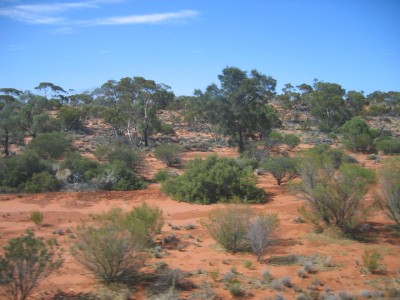 |
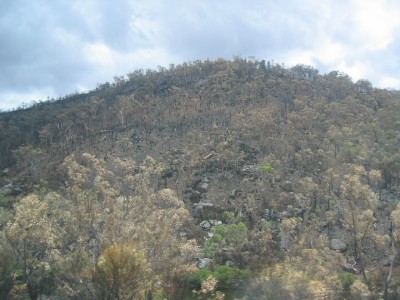 |
That night another superb dinner was served and just as I was knocking back
my post-meal coffee, an announcement was made that we were to move our clocks
1 and ½ hours ahead to South Australia time, meaning that we went from
8:00PM to 9:30PM in a flash and I suddenly realized that I had just caffeinated
myself into an unintentionally late night. This realization was made even worse
when we were reminded that we would be roused at 6:00AM the next morning for
an early breakfast in anticipation of our 7:00AM arrival in Adelaide. Arg. Clearly
God wanted me to be sleepless and cranky. I moved into the lounge car and ordered
a nightcap glass of Riesling in the hopes of counteracting the coffee and then
returned to my room at 10:30 to sit bug-eyed until well past midnight.
Everyone in Australia poo-poos Adelaide even worse than Canberra, likening
the city to Hell-in-Australia. In fact, Adelaide bashing was a recurring theme
at the comedy night at Base Backpackers in Melbourne (e.g. after experiencing
a regrettable action or event, indicating that he’d rather be anywhere
else, no matter how dismal, one guy commented; “I have never wished that
I was in Adelaide so much in my life.”).
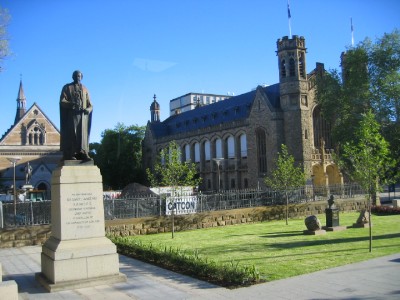 |
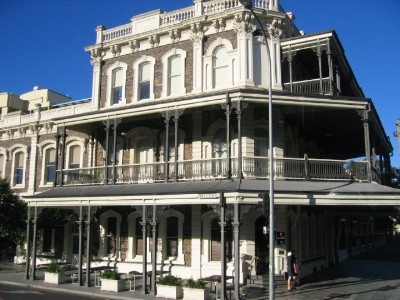 |
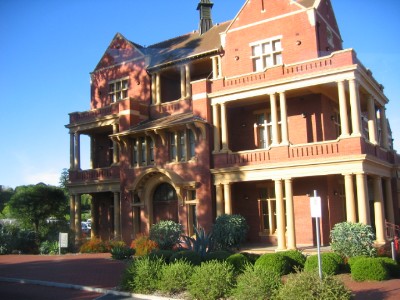 |
Adelaide is actually quite nice, though that was only my first impression from
the 90 minute bus tour. Central Adelaide is one square kilometer, surrounded
by a giant perimeter of parkland. The story is that Adelaide’s designers,
worried about potential attack, created the perimeter parkland as a defense,
making it exactly as wide as the distance that a cannonball could be fired at
the time. The city is clean, orderly and not overly crowded (the bus driver
said that, with the wide streets and relative scarcity of vehicles, rush hour
generally lasts about 15 seconds). The bulk of Adelaide’s buildings and
houses were built in thick stone, as there is negligible workable wood to be
found in South Australia. This makes for unusual and pleasing surroundings,
not to mention that all that thick rock had the added advantage of rescuing
all those people from the fantastic heat that they experience at the height
of summer. The businesses were generally of the same style seen in most small
Aussie cities, less than three stories tall, with wide verandas that wrap around
½, sometimes ¾, of the building and exuding an all-around colonial
air.
Adelaide is also known as “The City of Roses.” The soil and weather
in South Australia is perfect for roses and they literally grow like weeds in
Adelaide, virtually unattended. Roses are everywhere, despite the very dry summer
that South Australia was experiencing, even thriving on the boulevards of Adelaide’s
busiest streets, engulfed in the fug of exhaust fumes.
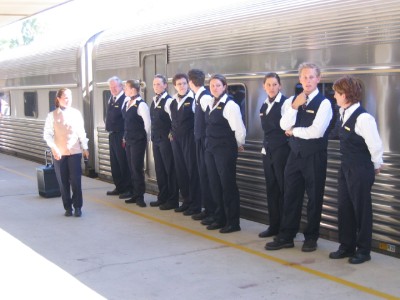 |
We were whisked back to the train station just in time to see the introductions
of the new staff taking over the IP for the trip from Adelaide to Sydney and
then we were off. The new train staff we acquired in Adelaide was a huge step
down in numerous ways. Most notably, the new staff did not know that I was to
be treated like a king, meaning that I had to kiss the free tours and unlimited
bar access goodbye (later on I decided this wasn’t such a bad turn of
events, as it left me the freedom to get stinking drunk that night for New Year’s
Eve without fear of damaging my professional demeanor, or worse, my behavior
getting back to the Rail Australia marketing department). Additionally, the
new crew were not on their service game at all. Spills and inattentive mistakes
in the dining car were constant. No one made any effort to memorize guests names,
drink or coffee preferences. The new Gold Kangaroo manager was anti-social when
she wasn’t totally absent and the general train manager had an irksome
love affair going on with the public address system, which she used liberally
to make long-winded, repetitive and incoherent announcements. Her ramblings
disturbed my nap three times in an hour and repeatedly interrupted my desperate
editing on the Salzburg piece, driving me into a muttering fury.
Things went from bad to worse from there. An hour out of Adelaide the train
stopped in the middle of the tracks and the train manager promptly got onto
the P.A. to announce at great length that the train was suffering a brake failure
and we were going to be stopped for a while as they fixed things up. After 37
or so follow-up announcements, over the course of the 45 minute stop, the train
manager updated us on the fact that she had no idea what was going on before
we were finally on our way again. Soon after she was on the air again to announce
that the delay had put us so far behind that the off-train tour of Broken Hill,
our next stop, would have to be cancelled. I was slightly bummed out as this
promised to be the best tour of all, with Broken Hill’s many mining attractions
that we would mercifully be able to view under glorious daylight conditions,
but knowing how much work I had left, I was a bit relived as well and sat back
for more intense editing.
Now comes the fun part. After a short stop for leg-stretching in Broken Hill,
we all diligently re-boarded the train and went nowhere. This was not lost on
us as we dug into lunch and sure enough the P.A. was fired up to clarify things.
Over the course of a tedious, repetitive 10 minutes, the train manager tried
to explain that a shipping train had derailed ahead of us (!) and we would have
to wait to hear how bad it was before moving. It didn’t occur to me until
much later that if it weren’t for our failed breaks and the lost time
in fixing them, that it probably would have been our train smashed and broken
up ahead, but at the time, I was more distracted by the groans and nearly immediate
round of bitching by the more objectionable passengers. Among the most vocal
were the two rotund businessmen that had boarded in Adelaide, who couldn’t
have been more pompous, arrogant and offensive if they were a part of the Bush
Administration. I happened to be eating with this duo at the time and after
the unpleasant lunch was capped off with their whining, I made a point of coming
to the next meal late, in order to be forced, through no fault of my own, to
sit with other people. There were also two older British women who had been
with us since Perth, who spent the entire trip drinking in the lounge car and
bitching in slurred tones about how much they disliked Australia to whoever
would listen, usually bemused Australians. The derailment set one of them off
on how “unreliable” the whole country was and made a general announcement
that she would be appearing in person at the offices of Rail Australia to demand
a full refund for her trip because of this indignity.
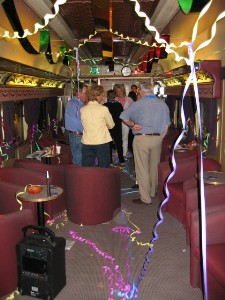
The lounge car, just after midnight. |
Four hours and 274 jabbering announcements later, we were still sitting at
Broken Hill and it was finally revealed that the derailment was far too severe
for us to continue. It would take at least two days to clear the line (much
of the line that the IP uses is a single line of tracks, as Australia is so
big and the rails are not busy enough to warrant two sets of rails, meaning
a lot of jockeying is done at a few designated passing areas to get oncoming
trains out of each other’s way). We would have to sit at Broken Hill until
6:00AM before returning to Adelaide. We were not able to leave for Adelaide
immediately, because by that time our train drivers had been on duty for over
eight hours and by law they were required to rest for 11 hours for every eight
hours of work. This news predictably sent the businessmen and the British bitches
into a tirade that lasted so long that I left the dinning car (where some of
us had gathered for the announcement) with a full glass of wine. Despite the
now clear realization that fate had just spared me from experiencing a possible
deadly train derailment, I took a little comfort in knowing that now I would
have at least an extra four hours in the sweet privacy of my cabin to get a
full nights sleep and bang out a little more work. However, these good intentions
were thwarted when, in a clear move to shut up the complaining foursome, the
train staff closed the cash register at the bar and just started pouring the
booze willy-nilly. Well, it was New Year’s Eve after all and I am not
ashamed to say that I consumed their entire stockpile of Riesling. I spent much
of the night out on the train platform with a few of the more agreeable Gold
Kangaroo people and much of the train staff, who doted on us with free booze
and tasty appetizers that the train chefs had whipped up. Broken Hill’s
main social club was directly across the street from the train platform and
we were able to monitor the people arriving for the New Year’s festivities,
some already so drunk that they were puking and pissing themselves before they
even hit the door. I went into the club twice to use the phone and the bouncers
were adamant that I spend the night partying at the club, preferably in the
company of all of the other train passengers. If I didn’t know better,
I’d have thought that they had shares in the club. Having already seen
the state of the guests in the club and knowing there was an open bar back on
the IP, I sincerely promised to return and then scurried back to the train to
hide.
I finally retired to my room with a heaping glass of wine at 2:00AM, where,
as you do, I decided I was not ready for sleep quite yet and popped “Pulp
Fiction” into my laptop. I finally went to sleep at 4:00.
My new porter woke me up two hours later with my wake-up coffee, which went
cold as I immediately pass out again. I was roused again an hour later with
the announcement that breakfast had already been served. The train had started
back to Adelaide at 6:00AM and was moving at what I determined to be top speed,
making the usual swaying of the train very pronounced, which did not help my
still-drunken footing. I struggled through the four cars between mine and the
dinning car to quietly inhale breakfast before staggering back to my cabin where
I slept all the way to Adelaide. So much for that extra work.
When the 15 minute warning of our arrival in Adelaide was announced, I got
up and managed to take a shower and get packed through the haze of a serious
hangover, finishing just as we came to a complete stop at the platform.
I was a mess. My fleeting drunken sleep had been sorely inadequate, which was
not helping the fact that my head was throbbing and working at ¼ speed.
I was nearly the last person in line at the IP desk in Adelaide to receive my
slapped together flight itinerary that would get me to Sydney by 8:00PM that
night. I was on a chartered bus to the airport minutes later and managed to
stay upright, talking to other IP passengers until we went our separate ways
to our planes.
While waiting to board my plane, I caught the news on a concourse TV and learned
that now there were 120,000 reported dead in Asia after the tsunami disaster
and they expected this number to climb to at least 150,000, not counting the
deaths that would no doubt ensue as disease started to sweep the area. I thought
back to when I was originally planning my trip. It was early on in the planning
stages, but at one point my itinerary would have had placed me somewhere in
Southeast Asia at the eventual time of the tsunami. Additionally, if it had
not been for the train’s bad breaks and us being passed by that freight
train, I would have likely been thrashed around to some degree by the derailment.
In other words, through fate, luck and the adjustments to my initial poor trip
planning, I had managed to dodge two disasters in the space of five days. Yes,
this seemed to be a dramatic and unnecessarily fatal way of looking at things,
kind of like the people who might have been standing in the World Trade
Center subway station on the morning of 9/11 if they hadn’t cancelled
their trip to Manhattan six months earlier, but nevertheless on some level I
knew that I was one blessed sonofabitch and that, without a god of my own to
thank, I had instead better return that good karma to the universe as soon as
possible.
Pre-derailment, I would have arrived in Sydney at 10:00AM on the 1st, at which
point I would have crossed the harbor to Luna Park to attend a very expensive,
day long club party. As it was, I arrived at 8:00PM, totally exhausted and hungover
and not the least bit interested in a party. I wanted to just pass out on a
couch at the airport and tranquilly wait for my flight to Wellington, New Zealand
at 10:00 the next morning. But I had spoken to my friend Deb by phone while
I was waiting in Adelaide and she convinced me to store my luggage and come
into the city where we’d hang out at the party for a while and then take
a cab to a friend’s house where I was welcome to sleep on the couch until
I had to head back to the airport. I was terrible company, but this is exactly
what I did and ended up so deeply asleep on my 10:00AM New Zealand flight that
I didn’t even sense our take-off.
|